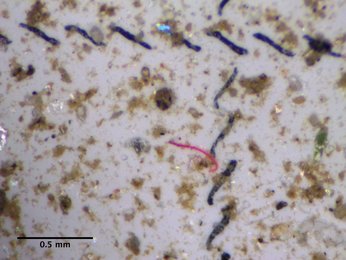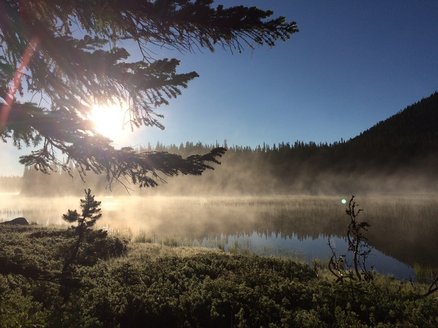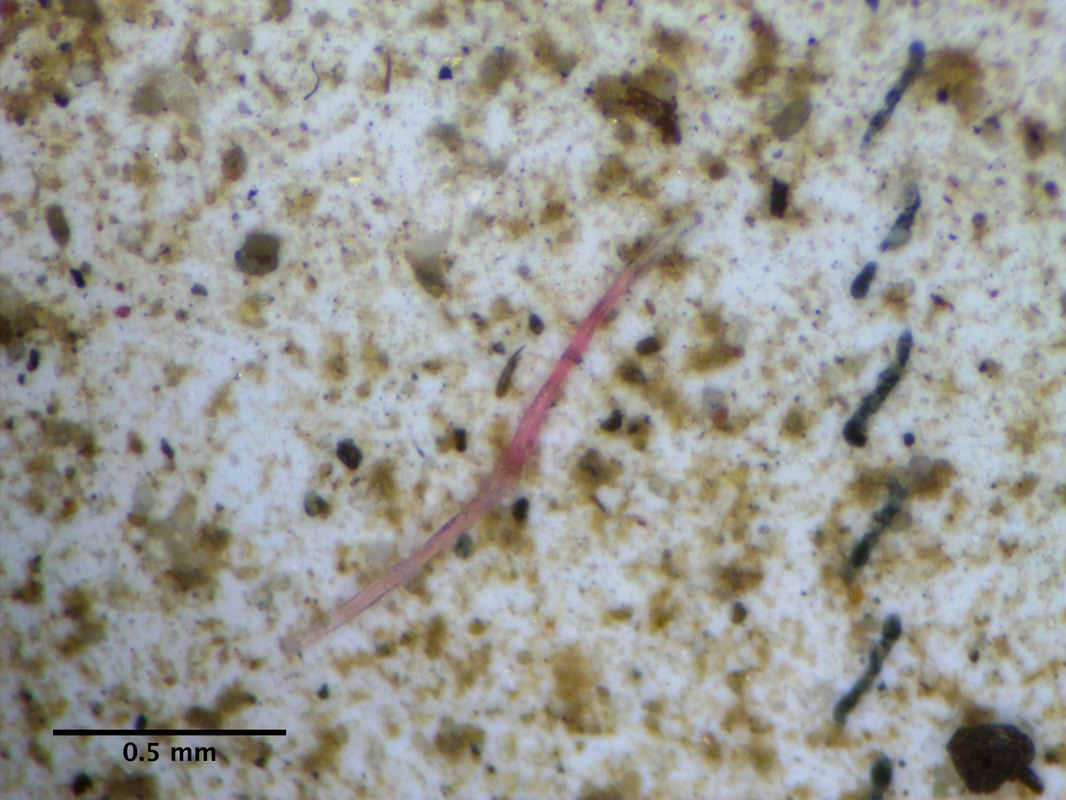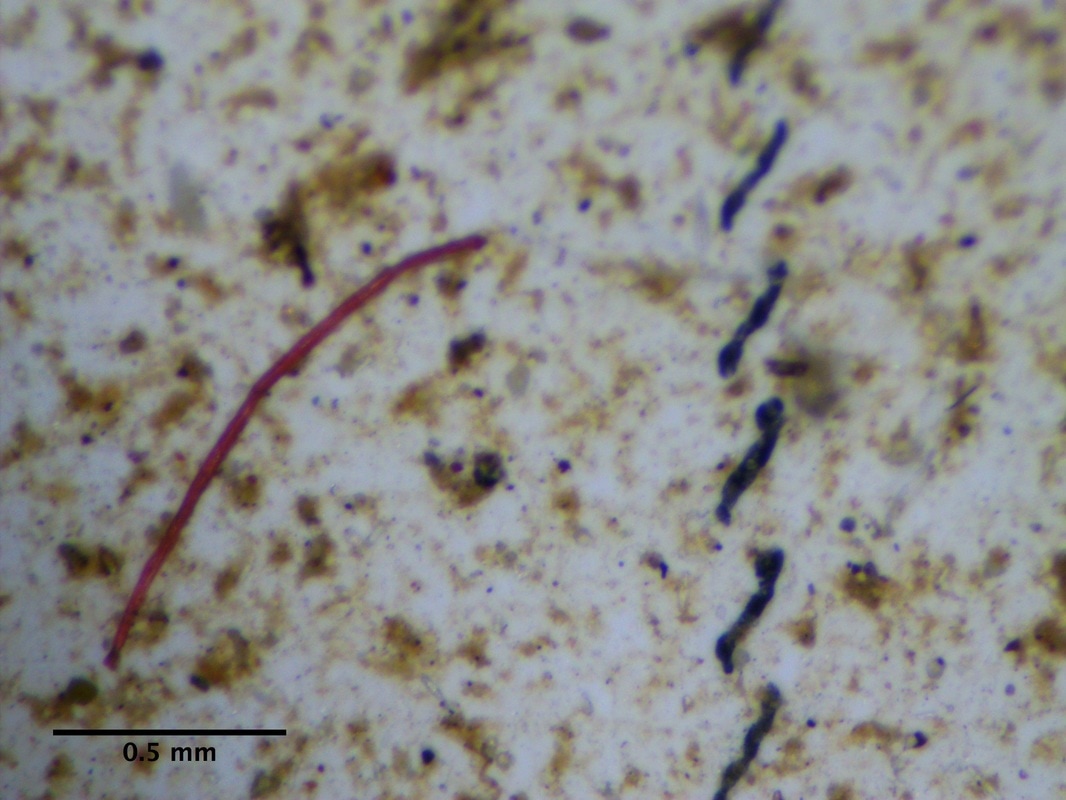 A red microfiber from Kirra and Gerrit’s sample one.
A red microfiber from Kirra and Gerrit’s sample one.
Thank you for collecting water samples with the Adventure Scientists’ Worldwide Microplastics project. Your efforts are helping us understand the distribution and concentration of microplastics in the world’s waters, while also building the largest microplastics dataset ever. Principal Investigator Abby Barrows has processed your microplastics samples, and we’re excited to share the results of your work!
Lab Process
First, let me briefly explain the process your samples go through in the lab. Once Abby receives your sample, she vacuum pumps each sample over a filter. After the filter has dried, Abby uses a microscope at 45x magnification to look for pieces of microplastic that are less than 5 millimeters. Moving along the grid lines, the filter is systematically counted, with each plastic piece categorized based on shape (round, microfiber, other) and color (blue, red, black, transparent/white, other). The final count for the sample is divided by the sample volume. This calculation helps to standardize the results, as incoming water samples are often not exactly one liter of water.
Project Results
To date, 1705 of 2238 samples analyzed (76%) contained microplastics. 87% of marine samples contained plastic, while 49% of freshwater samples contained plastic. 24,516 pieces of microplastic have been counted. On average, we are finding 9 plastic pieces per liter of water. You can check out the number of pieces per liter in each individual sample on the map on our microplastics page.
Note: In the results listed here, we report the total microplastic pieces found in your sample. However, for many of our calculations and for the online map, we report the total pieces per liter. As such, your microplastic total on the map may appear different from your total below.
Also, please let us know if your sample isn’t located in the correct place on the map, so that we can fix it for you.
Expedition-Specific Results
Avoiding Barges
Kristopher Laurie
Missouri and Mississippi Rivers
Kris collected 13 samples, which contained one blue microfiber and one clear microfiber. Kris has extensive experience in conservation and is currently studying Natural Resources Management. He collected his samples while paddling the Missouri and Mississippi Rivers from Montana to the Gulf of Mexico.
Back River Expedition
Julie Fix and Seth Norell-Bader
Canada
Julie and Seth collected three freshwater samples, which didn’t contain any microplastic. Julie is a currently studying chum salmon in the Puget Sound, and Seth is an environmental science educator. They collected their samples while paddling over 750 miles on the Back River.
Karnali Return
Kirra Paulus and Gerrit Egnew
Nepal
Kirra and Gerrit collected six samples, which contained one clear fragment and one red microfiber. Kirra and Gerrit first started collecting microplastics samples for Adventure Scientists by participating in the Gallatin Microplastics Initiative. They’ve since gone on two expeditions, so they could contribute to our Worldwide Microplastics Initiative. This trip, they collected samples while whitewater kayaking in Nepal. Stay tuned for a future Field Notes blog post about their experience!
Meghan Elgan, Monique Dykman, and Porkchop
Ohio River
Meghan and Monique collected six samples, which contained one black microfiber. Meghan is the Educational Coordinator for Living Lands and Waters. She teaches and coordinates student workshops about environmental issues in our nation’s rivers.
Ripple Crew
Maxine Graves, Niara Brown, Luke Rosa, and Elizabeth Crawford
Yosemite National Park
Maxine is the President and Niara, Luke, and Elizabeth are members of the Environmental Camping club and they collected their samples from Merced River. They collected five samples, which contained one red fragment and one blue microfiber.
RV Calpyso
John Griffith
Canada
John collected 12 samples, which didn’t contain any microplastic. John is a boater, environmental enthusiast, and renewable energy developer. He collected his samples while sailing from Owen Sound to Twelve Mile Bay.
Adria Magrath
Idaho, Oregon, and Washington
Adria collected 27 samples, which contained three clear microfibers and two black microfibers. Adria is a Biology professor who took her samples over the course of several different adventure trips. She collected her samples while whitewater rafting the lower Salmon and Snake Rivers, backpacking in Olympic National Park, and swimming in Puget Sound. You can learn more about Adria’s trip from her post in our Field Notes.
Abby Barrows and Ben Jackson
Maine
Abby and Ben collected eight samples, which contained five pieces of microplastic: three blue fibers and two clear fibers. Abby is the Microplastics Principal Investigator at Adventure Scientists. She and Ben collected their samples canoeing on the Penobscot River.
Wyss Retreat
Kat Fiedler and Katie Holsinger
Yellowstone River
Kat and Katie ten samples, which contained two blue microfibers, one red and clear microfiber, three red microfibers, and one clear microfiber. They collected their samples while they floated the Upper Yellowstone River with Montana Whitewater.
Though we’re finding an average of 9 pieces per liter for the project overall, there is much more microplastic in marine samples. The concentration of microplastic in marine samples is over 12 pieces per liter. This is much greater than the concentration in freshwater samples, which is over 1 piece per liter.
Another interesting trend we’re seeing is 90% of the microplastic we’ve counted is fibrous: the pieces are thread-like or line shaped. Finding a majority of these fibers in samples could suggest that microfibers are the primary microplastic input into waterways.
Thanks so much, again, for your dedication to this program and our shared waterways!



